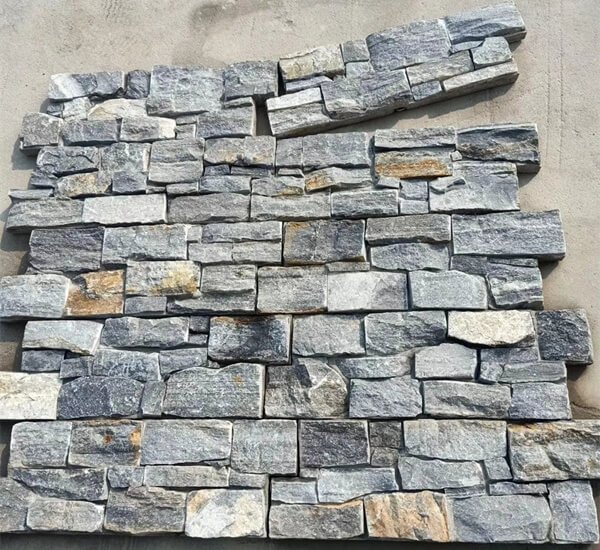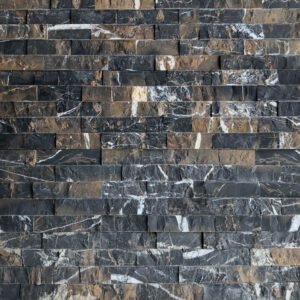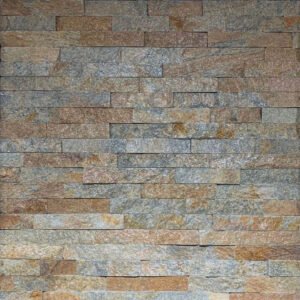What exactly is Blue Diamond Quartzite?
Blue Diamond Quartzite is a natural metamorphic stone formed from sandstone subjected to intense heat and pressure deep within the Earth’s crust. This geological process creates an exceptionally hard, dense crystalline structure composed primarily of interlocked quartz crystals. The distinctive blue-grey coloring results from naturally occurring mineral variations within the stone. True quartzite ranks 7 on the Mohs hardness scale, making it harder than granite and significantly more durable than marble for architectural applications.
How durable are Blue Diamond panels compared to other materials?
Blue Diamond Quartzite panels rank among the most durable cladding materials available. The 7 Mohs hardness rating provides excellent scratch resistance, while the dense, low-porosity composition resists staining, water absorption, and freeze-thaw damage. Quartzite outperforms marble (3–5 Mohs hardness) and granite (6–7 Mohs hardness) in scratch resistance and acid etching resistance. With proper installation, Blue Diamond panels maintain appearance and structural integrity for 50+ years through varied climate conditions, UV exposure, and weathering.
Can these panels work in cold climates?
Yes. Blue Diamond Quartzite’s low water absorption rate (less than 1%) and dense crystalline structure provide excellent freeze-thaw resistance. The stone withstands repeated moisture infiltration, freezing, and thawing cycles without cracking, spalling, or surface damage. This performance suits projects in northern climates, mountainous regions, and areas experiencing significant seasonal temperature variation. Proper substrate preparation and drainage management further enhance cold climate performance.
What installation methods work best with these panels?
The interlocking Z-profile design permits two primary installation approaches. The most common method uses high-performance stone panel adhesive applied to both the substrate and panel backing with a notched trowel. Panels interlock sequentially, creating seamless joints without mortar. For exterior applications or heavier installations, contractors reinforce adhesive bonding with mechanical fasteners (screws or metal clips). Both methods work effectively; adhesive-only systems suit interior and protected exterior applications, while mechanically-fastened systems provide additional security for high-wind or heavy-snow regions.
How much preparation does the substrate require?
Substrate surfaces must be clean, flat, and sound—free of dust, oil, loose paint, or contaminants that compromise adhesive bond strength. Surface flatness tolerances should not exceed 1/8″ variation in any 10-foot span. Gypsum surfaces require primer application before mortar-based adhesive installation. Concrete surfaces should cure for minimum 28 days. Existing masonry or brick substrates need cleaning and, in some cases, surface sealing. Proper preparation takes several hours but proves critical for installation success and long-term panel performance.
What adhesive products work with Blue Diamond panels?
High-performance stone panel adhesives specifically formulated for quartzite and natural stone applications deliver optimal results. ARDEX X 7 and equivalent premium-grade products provide strong bonding, adequate curing time for positioning, and long-term durability. Select adhesives compatible with quartzite surfaces and verified not to cause staining or damage. Avoid low-quality mortar products, concrete bonding adhesives, or general-purpose masonry products. Always follow adhesive manufacturer’s mixing instructions, application rates, and curing times to ensure proper performance.
Are these panels suitable for high-traffic areas?
Absolutely. The 7 Mohs hardness rating ensures exceptional scratch resistance in high-traffic environments. Commercial lobbies, retail spaces, and public walkway walls benefit from quartzite’s proven durability under heavy use. Unlike marble or limestone, Blue Diamond panels resist damage from foot traffic, furniture contact, and typical commercial wear. The non-porous surface discourages staining from common commercial contaminants. Installation in these applications delivers lasting aesthetics with minimal maintenance.
What maintenance do installed panels require?
Blue Diamond panels require minimal regular maintenance. Simple water-based cleaning with a soft cloth addresses most surface dust and dirt. For more thorough cleaning, mild soap solutions or specialized stone cleaners work effectively. Avoid acidic cleaners, harsh chemicals, or abrasive scrubbing that could damage the surface. Annual inspection for any loose panels or joint deterioration permits early corrective action. No regular sealing applications or protective treatments become necessary under normal conditions. This simplicity makes Blue Diamond panels ideal for owners seeking low-maintenance solutions.
Can these panels be cut or customized on-site?
Yes. Contractors can cut panels using diamond blade saws to accommodate wall dimensions, openings, or corner conditions. Standard masonry saws equipped with diamond blades cut through quartzite cleanly. Wear proper safety equipment including dust masks and eye protection when cutting. Allow cut edges time to cure and stabilize before final installation. Pre-planning cuts during initial substrate measurement minimizes waste and installation delays. Most contractors complete cutting work within standard project timelines without scheduling complications.
What’s the difference between Blue Diamond panels and other stone cladding systems?
Blue Diamond panels offer several advantages compared to traditional mortared stone veneer or full-bed stone systems. The interlocking design eliminates mortar, reducing installation time and labor costs. Pre-fabricated panels arrive production-ready, with no on-site sorting or selection required. The standardized Z-profile ensures consistent joint alignment and appearance. Individual panels weigh approximately 7.1 kg, making handling and positioning simpler than full-bed stone (20–35 kg per piece). These efficiency advantages reduce overall project cost while maintaining authentic natural stone appearance and performance characteristics that full-bed systems provide.
How do shipping and delivery logistics work?
Standard shipping containers (20-foot or 40-foot) accommodate our quartzite panels with efficient packing that maximizes container capacity while protecting product during transit. A typical 20-foot container holds approximately 338 m² of finished panels. Professional loading and securing protocols prevent shifting during ocean transport. International sea freight typically requires 18–25 days after order confirmation from factory to destination port. Minimum order quantities of 100 m² accommodate most commercial projects economically. Flexible minimum order policies apply for qualified repeat customers or long-term supply agreements. We coordinate shipping logistics and can arrange delivery to your project site or preferred location.














